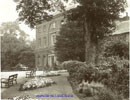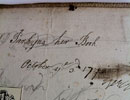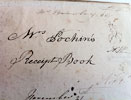Old Braunston Hall, Leicestershire.
Three vellum bound volumes dated from the 17th, 18th and 19th Centuries.
Volume 1. 182x120mm. dated 1659. Volume 2. 207x107mm. dated 1772. Volume 3. 195x158mm. dated 1844. ---- VOL.1: - On paste- down, the name of C[lemont] Winstanley, April 1659. Written in two hands in black and brown ink, in a slightly messy script. The first 39 pages are mixed receipts in medicinal, cookery, wine and veterinary. The next 25 pages are blank. The last 12 pages at the back are written upside down to the front. They consist of very interesting lists recording the distribution of fish from one pond to another. there are four dates: 1790, 1799, 1805, 1806. Some pages have been cut and removed from the front and back of the book. VOL. 2: - The front paste-down states this book belongs to T.Parkyns her book, October 3rd, 1772. At the back there is also an inventory of Mrs Winstanely's linen dated, July 21st, 1788. The first 104 pages are daily shopping lists in a fairly messy script. The next are 4 blanks then 10 pages of cookery receipts. VOL. 3: - The front paste-down has in bold ink - Mrs Pochin's Receipt Book. It also states intriguingly in ink, another name and date - Mrs Binley, 1651. Before marriage to Ralph George Pochin (also known as ‘George’) of Barkby Hall, Leicestershire. Mrs Pochin had been Anna Jane Winstanley. The book probably belonged to, and was inherited from either her mother or mother-in-law, as the recipe on page 82 is dated 1844, 18 years before she was born. The other date of 1651 probably came from a very early branch of the Pochin or Winstanely families called Binley. (further research has not solved the puzzle). The first 82 pages are filled with recipes in a neat longhand script. Most of them have names attached with many attributed to Mrs Smith and a few to Mrs G. Pochin (Anna Jane Winstanley). The rest of the pages, a little over half are blank. There are two dates of 1807 within the text and a last date of 1844 in the last written recipe. There is also another undated, loose 32 page manuscript, in a very neat but earlier script in faded brown ink. The pages are also slightly bigger (approx 10mm all round) and more age browned than the book indicating it came from another much earlier family cookery manuscript, very possibly pre-dating the first volume. One of the recipes is attributed to Mrs Winstanley and another to Mrs M. Pochin. Given the variance between the two dates of 1651-1844, indicating these recipe books were in use for a minimum of 193 years, with the dis-bound manuscript pages indicating even earlier.
- All three volumes were the property of the Winstanely Family of Old Hall, Braunstone, and the Pochin Family of Barkby Hall, both in Leicestershire. Book 1. was the property of Clemont Winstanely. Baptised, January 15th. 1644-1672. Book 2. belonged to Jane Parkyns who was married to a later Clement Winstanley, born 1739, died 1808. Jane herself died one year before in 1807. Book 3. belonged to Anna Jane Pochin (nee Winstanley) born 1862, died 1910. Her brother James died unmarried so for the first time the succession went to his sister. She had married Ralph George Pochin of Barkby Hall, Sheriff of Leicestershire who had also been a Commander RN. The Winstanleys’ came to Braunstone in the mid 17th century. James Winstanley (the father of Clement) purchased the estate from the executors of the Hastings family after the death of Henry Hastings’ in 1649, for the sum of £6,000. A quitclaim in 1651 gave him freehold interest in the estate of Braunstone. The Winstanley’s played a vital role in determining the future economic and social history of their properties in and around Braunstone and Kirby Muxloe for the next 275 years. They had a reputation for being fair-minded and judicious, holding important roles as leading dignitaries in The Leicester Corporation. Their decisions influenced the lives of the communities of both Braunstone and Leicester. James Winstanely, Clemont's father was a puritan and a lawyer by profession in the service of the Duchy of Lancaster before taking up residence in Braunstone. He and his wife Catherine had three children. James was a member of Grey’s Inn and the Recorder of Leicester, a position he held until his failure to conform in 1662. While in office he Proclaimed Oliver Cromwell as Lord Protector. He died in 1666 and the estate passed to his eldest son Clement. Clement like his father was a member of Grays Inn and his wife was also called Catherine. Clement died in 1672 and was buried in the family vault under the alter of the 12th century church of St. Peter’s in Braunstone village. Their eldest son James became the third Winstanley to inherit the estate. He was also a member of Grays Inn and M.P. for Leicester. James married Frances, daughter of James Holt of Castleton and their only son, also named James, took over on the death of his father in 1719. He was elected to the post of High Sheriff of Leicester and married his cousin Mary Prideaux. In 1750 he bored for coal near the lakes on Braunstone Park, hoping to cash in on the lucrative trade. But one night after two weeks of hard work by his estate hands, saboteurs, thought to be from the Leicestershire Colliers, filled the bore hole with rocks and stones. With his attempt to find coal thwarted he never continued with the venture. He died in 1770. James was succeeded by his son, another Clement. In 1775 he commissioned the local architect and builder William Oldham (who later became the Lord Mayor of Leicester) to construct the present Braunston Hall . The design typical of the period, a solid Georgian residence. (See image 1. below) The Hall was built on a rise with views overlooking Charnwood forest and set in one hundred acres of fine parkland. Clement also held the Office of High Sheriff of Leicester and in 1774 a remarkable procession took place. It was the custom to accompany the Judge to the Assizes Court at the Leicester Castle. The procession left from Braunstone Hall in military fashion. Thirty gentlemen wearing blue coats with crimson collars, white waistcoats and breeches formed the main escort, with a further 400 horsemen in attendance. The spectacle drew large crowds of bystanders who cheered them on their way. His wife was Jane Parkyns (the owner of the second volume) sister of the First Baron Rancliffe of Bunny, Nottinghamshire. He died in 1808. Jane had died one year before. The next to become heir was their eldest son Clement, J.P. Lieutenant – Colonel of the Leicestershire Militia from 1802-9. He was also the Chairman of the Leicester and Swanington Railway, which opened in 1832. He died unmarried in 1855. The estate passed to his nephew James Beaumont, High Sheriff of Leicester. He was only thirty when he mysteriously disappeared while abroad in Europe. When a body was found floating in the river Moselle in Germany the Winstanley family hired the private detective “Tanky Smith” to go to Germany to identify the body. A butler from the hall accompanied him and on the evidence of some clothing and a pair of cufflinks the body was identified as James Beaumont. The year was 1862. James was unmarried so for the first time the succession went to a female member of the family, his sister, Anna Jane Pochin - nee' Winstanley (owner of the third volume). Anna Jane was married to Ralph George Pochin of Barkby Hall in Leicestershire. The Pochin family were also long established in Leicestershire, having lived in Barkby Hall since 1604. The Pochin Family Tree extends from the early 13th. Century and claims to cover 23 generations. There are still large gaps, with many Leicestershire Pochins missing. In 1904 Anna Jane relinquished the estate in favour of her son Richard Norman Pochin and moved with Ralph to Braunston Hall. Interestingly, Richard Norman Pochin, changed his name by deed poll to Winstanley. In 1911 he extended the south side of Barkby Hall by adding a wing with toilets and bathrooms. It was in 1925 while he, his wife and six children were still in residence that the Leicester Corporation compulsory purchased his land in Braunston for much needed housing. One of their children, Rosemary Philippa Winstanely born in 1914 at Braunstan Hall married Robert Poore. Their son Andrew Phillip Poore, born 1951 and the great (x 7) grandchild of the Clement Winstanley mentioned at the beginning, is the one who gave me these manuscripts. His mother passed away on the 6th Oct. 2006 at Brown Edge, West Malvern, Worcestershire. As an interesting footnote, Andrew Poore's family have a long and well documented history in the West Country. Richard Poore on the death of his brother Herbert Poore, succeeded him to the position of Bishop of Salisbury by 27 June, 1217. During his tenure he helped plan and oversee the construction of the new Salisbury Cathedral as a replacement for the old cathedral at Old Sarum. He also laid out the town of Salisbury in 1219, to allow the workers building the cathedral a less cramped town than the old garrison town of Old Sarum. Richard died on 15 April 1237. He is commemorated with a statue in niche 170 on the west front of the Cathedral he built. NB: I gratefully received an interesting e-mail from Edward Geoff Pochin on May 2011, who corrected me on some erroneous facts I had entered about the Pochin Family tree. Another Pochin - Marian Peacock, also mailed me and told me the sad story of Ralph George Pochin's aunt, an Ann (not Anna) Jane Winstanley who tragically burned to death in her London house in 1847.






click on image to enlarge

Antiquarian category
ref number:
11157